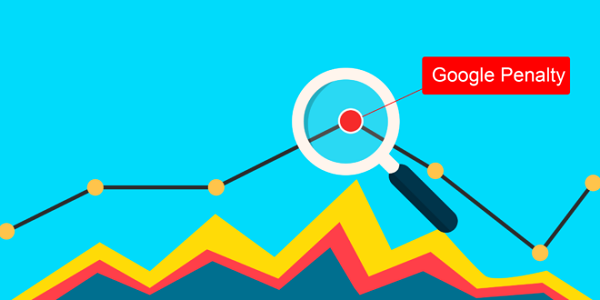
So you’ve received the “penalty” from Google. A penalty means that your rankings have been negatively impacted either by Google demoting your rankings thereby reducing your visibility or by “sandboxing” your website so it may not even appear on the search engine for your commercial keywords.
The cause of the Google penalty can be one of or a combination of a few things:
1 – A manual back link based penalization;
2 – A by product of an algorithm update;
3 – And other unknown reasons. (which I’ve seen but never been able to pin down a sudden decline in visibility and rankings to a manual review nor an algorithm update).
All of these penalties stem from the fact that your website would have been engaging in practices which break Google’s Webmaster Guidelines (To find it – just Google it!).
The negative impact of a Google penalty on your website can substantially hurt your business. Your visibility should be actively monitored day to day by either yourself or your SEO professional because when penalties are handed out, the organic traffic your receiving today can substantially decrease from anywhere between 20% or a lot more. (Think about what your business would do if it were to lose 100% of organic traffic which has happened in the past.) It can affect just one page, some keywords, sections of your site or your whole website. It’s a privilege and not a right to rank highly on Google and a lot of people – clients especially become easily complacent when they’ve found a “safe spot” and have grown comfortable.

Big businesses aren’t excluded from being penalized. BMW was one of the first big businesses that was made an example of in 2006 when Google penalized bmw.de for using doorway pages. Doorway pages in the context of SEO (landing pages for CPC/Adwords is a separate matter) are pages which you create with the intent of ranking only for a specific keyword or long tail keyphrase. Google doesn’t like these pages because they aren’t created to promote or contribute to the user experience and the pages themselves often have little useful value to users.
Other notable examples include: Google Chrome website in early 2012 for purchasing blog posts impacting their PageRank which dropped from 9 to 7 and lost rankings for keywords like “browser”. Expedia lost 25% of their search visibility in 2014, Rap Genius was penalized for 10 days with a drop of about 700,000 users a day and Overstock.com whose penalty impacted their revenue dropping year on year from $1.08 billion to $1.05 billion – that’s a $50 million impact!
The link based penalty is a tricky one to manage. Google frowns upon manipulative backlinks which are built specifically to help your website rank higher. As such, the penalty could be caused by any one of your links that you have built in the past which includes any links you paid for, comment/forum spam, blog networks, directory links and guest blog posts.
The suggested course of action is to first make an effort in cleaning up your links. This means contacting the website owners which link to your website and getting your backlinks physically removed. First target any link which is not scoring highly in your relevancy/popularity and trust test. After you’ve made some effort in removing some suspected culprit back links, monitor the situation for a while – a few weeks to a few months. If there is no change the next action would be to use Google’s Disavow Tool which was launched late 2012. This tool provides you with an upload facility where you can report all the suspected “bad” websites in a list format. The webspam penalty could also be caused by a Negative SEO attack where a hostile competitor may have targeted your website with spam links.
Your site could have also been impacted by a Google algorithm update. To find out if this was the cause, you’ll match the timing of the dates when every Google update was rolled out with the time when your website’s traffic or visibility (visibility is a calculated metric which different SEO software captures as a way to measure how high your rankings are for your list of target keywords) dropped. If you have a whole list of client sites to analyze the best course of action is to export out the session traffic numbers for a website either on a daily or a weekly scale and create a chart with the sessions (or visibility) on the y-axis and the dates on the x-axis. Next, overlay the data with the dates with all the algorithm changes which you can find easily on the internet. However, if you’re just checking for one website, you can just take the suspect date where your traffic made a substantial fall and match it up manually with the list of Google update dates.
Moz maintains a register of all dates of reported and suspect Google Algorithm updates which you can find here: https://moz.com/google-algorithm-change. Once you’ve found the offending algorithm update which affected your rankings, you can work to fix any relevant issues that the algorithm was targeting.
Finally, your site could be penalized for seemingly unknown/unseen causes. If there were no manual actions, your backlinks are legitimate and acceptable and the drop in traffic wasn’t caused by an algorithm update you’re left with having to do a complete SEO site audit to find any other possible causes.

Just Ask to get Free Professional SEO Consulting
Getting in touch with great SEO professionals can be difficult and they can also get quite pricey. Although that said, hiring the best SEO consultant can be priceless for a business and can have positive long term impacts on your businesses customer acquisition well into the future.
There are three free ways to get free SEO advice:
1 – Do-It-Yourself research through Google
2 – Ask your question in a public forum
3 – Ask for a free SEO Audit or a pitch from an SEO Agency.
The DIY approach to getting your SEO answers is self explanatory. However the key to really finding your answers amongst the multitude of search results is to know the relevant pieces of technical jargon to your problem. This will help narrow down the search results and give you a more definitive answer. Even if you aren’t sure of the problem, taking a rough guess might yield better results. For example, if you weren’t sure if you have set up your sitemap correctly, you can search for something like these search queries:
– Website XML sitemap checklist
– How do I check if my XML sitemap is setup correctly?
– XML Sitemap check
– Steps to setup an XML sitemap
If you have a more involved question which you can’t find the answer to, you can use one of many forums to ask your question. Just don’t go spamming all the forums with the same question. And make sure you’ve done your due diligence to check if your question hasn’t been answered before by using the forum search. Here are some forums:
– https://moz.com/community/q
– https://webmasters.stackexchange.com/
– https://www.quora.com/
– https://stackoverflow.com/
A (sneaky) tactical way to get some free SEO advice is to ask for a free SEO Audit or a pitch from an SEO Agency. A lot of SEO Agencies offers a free SEO Audit as a way to pitch their services. Sometimes clients would request a few agencies to pitch for a tender with competing Audits to see the differences in approach and quality of work to help with their own due diligence. As an SEO professional, this technique could be ethical or unethical depending on your viewpoint. This exercise helps clients understand your methodology and to see if your findings and recommended actions are on par or even better than your competitors. The best SEOs are the ones that do their due diligence so expect to get a request to view your Google Webmaster Tools (Search Console) and your Google Analytics.